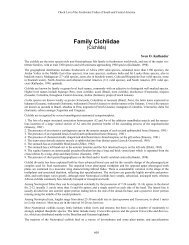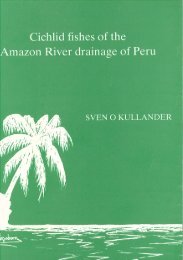Open Access PDF - Sven Kullander
Open Access PDF - Sven Kullander
Open Access PDF - Sven Kullander
Create successful ePaper yourself
Turn your PDF publications into a flip-book with our unique Google optimized e-Paper software.
on back, nape and dorsally on caudal peduncle;<br />
most flank scales with light centre and dark edge.<br />
Lower regions, including prepelvic area and<br />
abdomen back along ventral surface of caudal<br />
peduncle yellowish white. Head side grey-brown,<br />
lower jaw smoky, whitish branchiostegal membrane<br />
dusky dorsally, intermandibular region<br />
whitish with some dark pigment. Blackish halter<br />
stripe present. Lips, preorbital area, snout, forehead,<br />
dark grey. Chest and pectoral axilla dirty<br />
greyish; pectoral axilla internally dark grey. Black<br />
blotch, including light scale centra, covering extrascapulars.<br />
Black, not contrasted vertical bar<br />
across nape between levels of orbit and preopercle.<br />
Three blackish bars on side, from back close<br />
to dorsal-fin base down to below (bars 1-2) or to<br />
(bar 3) lower lateral line level, none ocellated.<br />
Dark scattered spots between bars give mottled<br />
appearance to flanks.<br />
Spinous dorsal fin black, immaculate; soft<br />
dorsal fin dark grey, with about seven vertical<br />
rows of white spots. Anal fin dark grey. Caudalfin<br />
ventral lobe uniformly grey, dorsal lobe<br />
lighter with about six vertical rows of silvery or<br />
white spots. Caudal fin ocellus of about diameter<br />
of orbit; black nucleus on and above lower lateral<br />
line level, ring silvery. Pelvic fin dorsally with<br />
rays and scale layer blackish; ventral side unpigmented<br />
but dorsal side pigment showing<br />
through.<br />
In adults 275 mm SL and larger, black bars<br />
often short, restricted to dorsum, blotch-like and<br />
contrasting against light side (Figs. 26-27), and<br />
black occipital bar pronounced. Blotches may be<br />
narrowly ocellated and usually additional scattered<br />
small dark spots present on dorsum or<br />
middle side. Abdominal blotches present with<br />
considerable variation, either as numerous smaller<br />
blotches or single elongate blotch extending<br />
caudad to bar 2. Spinous dorsal fin contrastingly<br />
black. This colouration found among specimens<br />
of both sexes, and tentatively regarded as breeding<br />
colour pattern because males with this pattern<br />
possess distinct nuchal protuberance.<br />
Live colouration (Fig. 26). Adults dull olivaceous<br />
or yellowish to golden or dark greenish with<br />
golden sheen on side, white ventrally. Narrow<br />
orange to yellow band from mouth angle to<br />
lower caudal fin base marking ventral extent of<br />
yellow/golden side. Caudal ocellus ringed with<br />
golden. Pelvic, anal, and lower half of caudal fin<br />
orange to dark red. Iris yellowish red. Vertical<br />
Ichthyol. Explor. Freshwaters, Vol. 17, No. 4<br />
323<br />
bars dark grey, not contrasted, or deep black,<br />
concentrated to dorsal blotches in large specimens<br />
and much more contrasted in living than in preserved<br />
specimens. Juveniles olivaceous with faint<br />
brassy sheen, ventrally white.<br />
Geographical distribution. Rio Solimões-Amazonas<br />
along the main channel and lower courses<br />
of tributaries (Fig. 23); in Peru from Yarina Cocha<br />
on the Ucayali north to the lower Napo in Peru<br />
and Ecuador; in Colombia at Leticia, in Brazil<br />
from Tabatinga to the Marajó island, including<br />
lower parts of the Tefé, Trombetas and Tapajós<br />
rivers. Also present in the Araguari and lower<br />
Oyapock rivers north of the Amazon. The species<br />
is probably much more widespread in the lowland<br />
Amazon basin than our records show.<br />
Habitat. Cichla monoculus has been collected in a<br />
number of different biotopes, but most commonly<br />
in floodplain lakes. In Peru adults were<br />
caught along the shoreline of both blackwater<br />
and whitewater floodplain lakes (<strong>Kullander</strong>,<br />
1986).<br />
Local names. Tucunaré, Tucunari (Peru; <strong>Kullander</strong>,<br />
1986). Toukounaré, Kounanni, Aboné,<br />
Tukunali, Malisamba, Toukounalé, Kunan, Toekoenari,<br />
Matawalé, Tucunaré açu (French Guiana;<br />
Keith et al., 2000). In Brazil, Tucunaré açu or<br />
Tucunaré comum seem to be widely deployed<br />
for this species, but it is obvious that açu (large)<br />
is also used for big C. temensis. Cichla monoculus<br />
is generally not distinguished from similar species,<br />
such as C. kelberi or C. pleiozona in the first<br />
place, and the general name tucunaré is applied<br />
on all.<br />
Notes. Cichla monoculus is identified with reference<br />
to the description and, particularly, the<br />
figure in Spix & Agassiz (1831). The description<br />
was made by Agassiz, the plate under Spix’s<br />
supervision (Kottelat, 1988). Agassiz cited as<br />
reference for his description of Cychla monoculus<br />
a 13" long specimen in spirit of wine, with the<br />
locality ‘mari Brasiliae’. The Spix and von Martius<br />
collection was destroyed when the Munich<br />
Museum was bombed in 1944. Kottelat (1984),<br />
however, recognized some material from that<br />
collection in the Museum d’Histoire naturelle de<br />
Neuchâtel (MHNN), where it was brought by<br />
Agassiz. One stuffed specimen of Cichla, MHNN<br />
2188, was identified by Kottelat (1984, 1988) as




